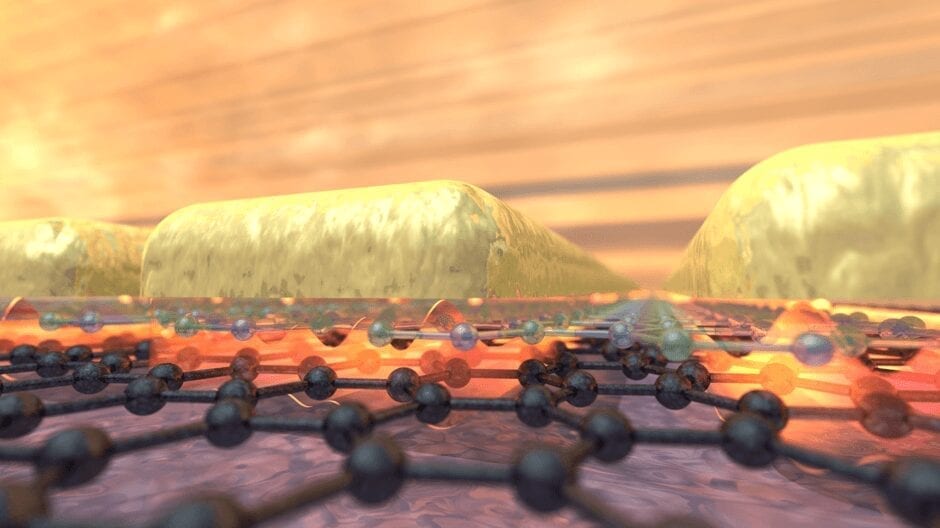
In a recent study published in Science, researchers at ICFO – The Institute of Photonic Sciences in Barcelona, Spain, along with other members of the Graphene Flagship, reached the ultimate level of light confinement. They have been able to confine light down to a space one atom, the smallest possible. This will pave the way to ultra-small optical switches, detectors and sensors.
Light can function as an ultra-fast communication channel, for example between different sections of a computer chip, but it can also be used for ultra-sensitive sensors or on-chip nanoscale lasers. There is currently much research into how to further shrink devices that control and guide light.
New techniques searching for ways to confine light into extremely tiny spaces, much smaller than current ones, have been on the rise. Researchers had previously found that metals can compress light below the wavelength-scale (diffraction limit), but more confinement would always come at the cost of more energy loss. This fundamental issue has now been overcome.
“Graphene keeps surprising us: nobody thought that confining light to the one-atom limit would be possible. It will open a completely new set of applications, such as optical communications and sensing at a scale below one nanometer,” said ICREA Professor Frank Koppens at ICFO – The Institute of Photonic Sciences in Barcelona, Spain, who led the research.
This team of researchers including those from ICFO (Spain), University of Minho (Portugal) and MIT (USA) used stacks of two-dimensional materials, called heterostructures, to build up a new nano-optical device. They took a graphene monolayer (which acts as a semi-metal), and stacked onto it a hexagonal boron nitride (hBN) monolayer (an insulator), and on top of this deposited an array of metallic rods. They used graphene because it can guide light in the form of plasmons, which are oscillations of the electrons, interacting strongly with light.
“At first we were looking for a new way to excite graphene plasmons. On the way, we found that the confinement was stronger than before and the additional losses minimal. So we decided to go to the one atom limit with surprising results,” said David Alcaraz Iranzo, the lead author from ICFO.
By sending infra-red light through their devices, the researchers observed how the plasmons propagated in between the metal and the graphene. To reach the smallest space conceivable, they decided to reduce the gap between the metal and graphene as much as possible to see if the confinement of light remained efficient, i.e. without additional energy losses. Strikingly, they saw that even when a monolayer of hBN was used as a spacer, the plasmons were still excited, and could propagate freely while being confined to a channel of just one atom thick. They managed to switch this plasmon propagation on and off, simply by applying an electrical voltage, demonstrating the control of light guided in channels smaller than one nanometer.
This enables new opto-electronic devices that are just one nanometer thick, such as ultra-small optical switches, detectors and sensors. Due to the paradigm shift in optical field confinement, extreme light-matter interactions can now be explored that were not accessible before. The atom-scale toolbox of two-dimensional materials has now also proven applicable for many types of new devices where both light and electrons can be controlled even down to the scale of a nanometer.
Learn more: Graphene Sets a New Record on Squeezing Light to One Atom
The Latest on: Light-matter interactions
[google_news title=”” keyword=”light-matter interactions” num_posts=”10″ blurb_length=”0″ show_thumb=”left”]
via Google News
The Latest on: Light-matter interactions
- Across the universe, dark matter annihilation could be warming up dead starson April 25, 2024 at 6:00 am
"The capture and annihilation of dark matter in neutron stars would provide a source of heating that stops the star from getting really cold." ...
- Making light 'feel' a magnetic field like an electron wouldon April 24, 2024 at 7:29 am
This finding could point to new ways to increase the interaction of light with matter, an advance that has the potential to improve photonic technologies, like very small lasers. This work, led by ...
- Exotic 'Einstein ring' suggests that mysterious dark matter interacts with itselfon April 16, 2024 at 1:00 pm
Last December, Yu led simulations of formations of structures incorporating self-interacting dark matter which concluded that such self-interactions could explain extremely dense dark matter halos in ...
- A single photon emitter deterministically coupled to a topological corner stateon April 2, 2024 at 11:29 am
More information: Mujie Rao et al, Single photon emitter deterministically coupled to a topological corner state, Light: Science & Applications (2024). DOI: 10.1038/s41377-024-01377-6 Provided by ...
- A single photon emitter deterministically coupled to a topological corner stateon April 1, 2024 at 5:00 pm
Exploring cavity quantum electrodynamics (cQED) is pivotal for advancing quantum technology and unraveling the fundamental intricacies of light-matter interactions. A prevalent strategy involves ...
- Ultrafast plasmonics for all-optical switching and pulsed laserson March 24, 2024 at 5:00 pm
Fundamental phenomena of plasmonic light-matter interaction and plasmon dynamics have been discussed by elaborating on the ultrafast processes unraveled by both experimental and theoretical ...
- Nanophotonics – harnessing light at the nanoscaleon November 13, 2023 at 12:56 pm
Today, the field of nanophotonics integrates principles from optics, quantum mechanics, and materials science to manipulate light-matter interactions at the nanoscale. The fabrication techniques and ...
- NGI shows rare physics with electrically tunable graphene deviceon April 7, 2022 at 5:00 pm
A research team led by The University of Manchester’s National Graphene Institute (NGI) has developed a tunable graphene-based platform that allows for fine control over the interaction between light ...
- Metamaterials and Metasurfaces: Engineered Structures Revolutionizing Light and Matter Interactionson August 18, 2020 at 1:09 pm
Metamaterials are a novel class of functional materials that are designed around unique micro- and nanoscale patterns or structures, which cause them to interact with light and other ... and lattice ...
via Bing News











